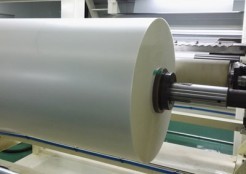Informations
Artificial marble, also known as engineered
marble, is a popular material in the construction industry due to its aesthetic
appeal, durability, and ease of maintenance. The production process of
artificial marble involves the use of molds that require effective release
agents for a smooth surface finish. In this essay, we will discuss the working
process of PVA water-soluble film for mold release during the production of
artificial marble.
Working Process of PVA Water Soluble Film
for Mold Release:
PVA water-soluble film is a type of polymer
film that dissolves quickly in water, leaving behind a clean and smooth
surface. The use of PVA water-soluble film for mold release in artificial
marble production involves the following steps:
Step 1: Mold Preparation
The mold is cleaned thoroughly to remove
any dirt or debris that may interfere with the film's adhesion.
Step 2: Cutting and Placing the Film
The PVA water-soluble film is cut to the
shape and size of the mold and placed over the mold's surface. The film should
fit the mold snugly to prevent any gaps or wrinkles.
Step 3: Pouring the Artificial Marble
Mixture
The artificial marble mixture is then
poured into the mold. The PVA water-soluble film acts as a barrier between the
mold and the mixture, preventing the artificial marble from sticking to the
mold during the production process.
Step 4: Curing
The artificial marble is left to cure,
allowing the mixture to solidify and take the shape of the mold.
Step 5: Removing the Film
Once the artificial marble has cured, the
PVA water-soluble film can be easily removed by washing the mold with water.
The film dissolves quickly in water, leaving behind a clean and smooth surface.
In conclusion, PVA water-soluble film is a
crucial component in the production of artificial marble. Its use as a mold
release agent ensures a smooth surface finish, prevents sticking to the mold,
and is environmentally friendly. The working process of PVA water-soluble film
for mold release during the production of artificial marble involves mold
preparation, cutting and placing the film, pouring the artificial marble
mixture, curing, and removing the film. This process is simple and effective,
resulting in high-quality and aesthetically appealing artificial marble.





